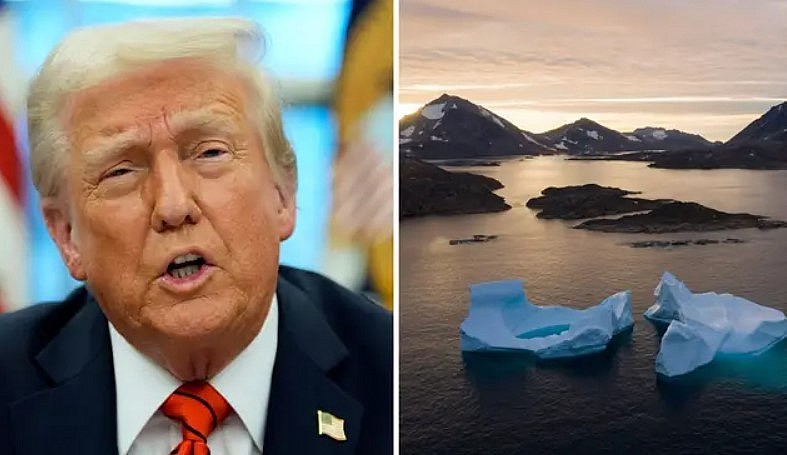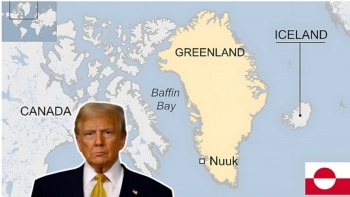From Greenland to ‘Red, White, and Blueland’ – America’s Wildest Land Grab Yet?
 Greenland’s Leader Múte Egede 'Opens the Door' for America Greenland’s Leader Múte Egede 'Opens the Door' for America |
 Who Is Mette Frederiksen? Denmark's Prime Minister Biography, Family Life, Career, And Net Worth Who Is Mette Frederiksen? Denmark's Prime Minister Biography, Family Life, Career, And Net Worth |
 |
| Trump given power to rename Greenland 'Red, White and Blueland' under new bill tabled by Republicans |
Recently, U.S. Representative Buddy Carter (R-Ga.) introduced a bill proposing that Greenland be renamed "Red, White, and Blueland" as part of an effort to support former President Donald Trump’s long-standing interest in acquiring the Danish territory. This bold proposal has reignited discussions on Greenland’s geopolitical significance, its historical names, and the feasibility of American ownership.
A Brief History of Greenland’s Name
Greenland’s name has origins dating back to its Viking discovery. Around the late 10th century, Norse explorer Erik the Red named the island “Grønland” (Greenland) in an effort to attract settlers despite its largely icy terrain. The name was strategically chosen to give an illusion of fertility, a stark contrast to its actual frigid climate. Prior to this, Greenland was inhabited by indigenous Arctic cultures, including the Saqqaq, Dorset, and later the Inuit, who referred to their land with various native names.
During its colonial period, Greenland remained under Danish rule, officially becoming part of the Kingdom of Denmark in 1814. While it achieved home rule in 1979 and further autonomy in 2009, Greenland has maintained its historical name, even as it continues discussions on potential full independence from Denmark.
Trump’s Interest in Acquiring Greenland
The idea of the United States purchasing Greenland is not new. In 1946, President Harry Truman attempted to buy Greenland from Denmark for $100 million, citing its strategic military importance. However, Denmark rejected the offer.
Former President Donald Trump revived the idea in 2019, calling Greenland a potentially “large real estate deal.” He saw Greenland as a valuable asset due to its location in the Arctic, abundant natural resources, and strategic military position in countering Russian and Chinese influence in the region. Denmark firmly declined the notion, with then-Prime Minister Mette Frederiksen calling it “absurd.”
Fast forward to 2025, and Trump has again expressed interest in Greenland, this time framing it as a necessity for national security and global freedom. With Representative Carter’s recent bill, the possibility of an American-led Greenland rebranding has once again become a topic of debate.
The 'Red, White, and Blueland' Proposal
On February 11, 2025, Rep. Buddy Carter introduced the "Red, White, and Blueland Act of 2025," which proposes renaming Greenland as part of the United States’ broader expansion efforts. Carter's proposal argues that integrating Greenland into the U.S. would strengthen national security and global influence.
According to Carter’s press release, “America is back and will soon be bigger than ever” with the potential acquisition of Greenland. The bill explicitly states:
"Greenland shall be known as 'Red, White, and Blueland.' Any reference in a law, map, regulation, document, paper, or other record of the United States to Greenland shall be deemed to be a reference to 'Red, White, and Blueland.'"
Despite the ambitious nature of the bill, it currently has no cosponsors, and Carter has not yet discussed it with Trump. Nevertheless, the bill signifies a symbolic gesture of Trump-aligned political interests in securing Greenland under American influence.
Geopolitical and Legal Challenges
While Carter’s proposal aligns with Trump’s vision, there are significant legal and diplomatic barriers to Greenland’s acquisition. Denmark has consistently affirmed that Greenland is “not for sale.” Prime Minister Mette Frederiksen has acknowledged the Arctic’s increasing geopolitical significance but emphasized that Greenland will remain under Danish sovereignty.
Frederiksen has, however, opened the door for increased U.S. military presence in Greenland, recognizing the shared interests in countering Chinese and Russian activity in the Arctic. This suggests that while an outright sale is unlikely, Denmark is willing to collaborate with the U.S. on security and defense strategies.
Moreover, Greenland itself has a growing independence movement, with many Greenlanders advocating for full sovereignty rather than changing hands from Denmark to the United States. Any decision regarding Greenland’s status would require the approval of its people, further complicating Carter’s proposal.
The Future of Greenland and U.S. Involvement
The introduction of the “Red, White, and Blueland Act” raises questions about America’s Arctic strategy and its long-term goals. While the renaming proposal may not gain traction, it underscores the renewed American interest in Greenland as a geopolitical asset.
With climate change opening new Arctic trade routes and exposing untapped natural resources, Greenland's strategic value continues to rise. The U.S. is likely to strengthen its presence through diplomatic agreements rather than territorial acquisition.
As of now, Greenland remains Greenland, but the political discourse surrounding its future is far from over. Whether it stays under Danish control, moves toward full independence, or entertains new forms of U.S. cooperation, its role in global politics will only grow in importance.
 Where is Greenland: Why Trump’s renewed interest Where is Greenland: Why Trump’s renewed interest On December 22, 2024, Donald Trump, on his TruthSocial platform, reiterated his interest in acquiring Greenland, calling it an “absolute necessity” for U.S. national security ... |
 Who is Múte Egede, Greenland’s Prime Minister, Who Said 'Not For Sale' Who is Múte Egede, Greenland’s Prime Minister, Who Said 'Not For Sale' Greenland, the world’s largest island known for its icy landscape and strategic location, made headlines when Donald Trump proposed buying it, but PM Múte Eged ... |
 Greenland, Canada, and the Gulf of Mexico: America First or America Everywhere Greenland, Canada, and the Gulf of Mexico: America First or America Everywhere Donald Trump’s presidency was marked by unconventional geopolitical statements and ambitions. |


























